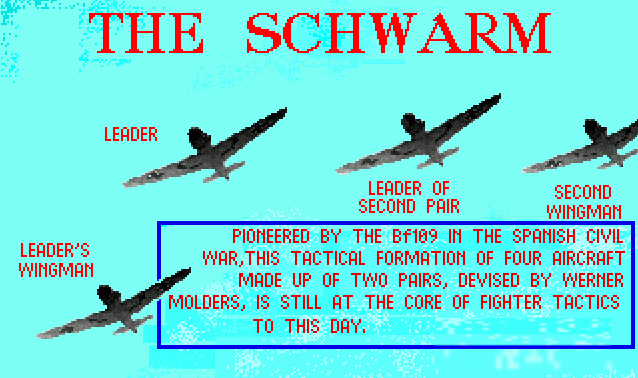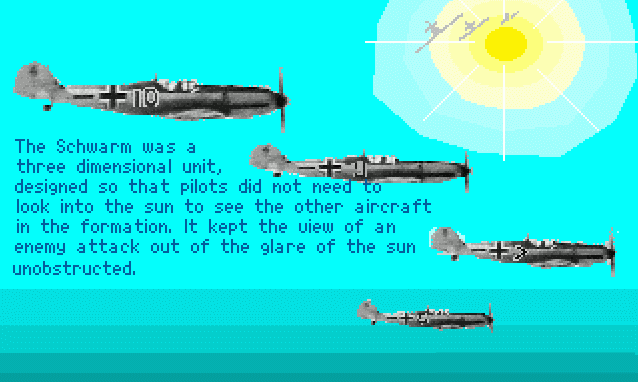Dinger's Aviation Pages
Luftwaffe fighter tactics
One of the things the Messerschmitt Bf 109 should be remembered for is the central position it took in the formation of fighter tactics for fast metal monoplane aircraft that appeared at the end of the 1930s, the same tactics that are still in use today.
During the First World War and the inter-war years the basic unit of aircraft was three aircraft flying in "V" formation known as a "Vic" by the RAF and a "Kette" by the Germans. First World War pilots had taken to flying this formation quite far apart to make their aircraft less easily seen and to avoid collisions, but in the "parade ground" atmosphere of peace, airforces tightened up the formations. The fashion for tight formation flying displays, at the public displays that were popular between the war, accentuated this development.
When the Messerschmitt 109 was committed to the Civil War in Spain, its pilots at first flew in the old "V" formations but a shortage of the new aeroplanes forced them to fly in twos when escorting bombing raids, in order to provide cover on all sides of the bombing formations. At this time there arrived in Spain Werner Molders, who took the two aircraft formation and extended its use and moulded it into the tactics needed by the new generation of aircraft such as the Bf109.

A two aircraft formation is much easier to handle than three. If the aircraft fly far enough apart there is less chance of collision. The leader concentrates on looking ahead while the wingman's attention is to the rear, making sure an enemy aircraft does not sneak up from behind. Remember that sight is the only sense available to a fighter pilot, he cannot hear an attacker, and at the high speeds attained by aircraft like the Bf109 another aircraft can change from a small speck in the distance to an executioner sitting on your tail in just a few seconds. The best form of fighter attack has always been out of the sun, where an aircraft is very nearly impossible to see against the glare. To guard against this the pair would position themselves so that each had a clear view of the sun, unobstructed by the other.

The pair of aircraft was called a "Rotte" by the Germans. Molders expanded it into the "Schwarm", two pairs acting together. Again the aircraft flew wide apart, the two leaders looking ahead, the two wingmen concentrating on the rear. The second pair would fly behind the leader of the first pair, stepped up away from the sun. The leader's wingman would fly behind and low. One of the reasons that the time for this sort of formation had come was the availability of air to air radio. A loose formation is only possible when the pilots are freed of flying close enough to see their leader's hand signals. A loose formation is much harder to see against the sky than a tight one, the Schwarm would only close up to keep contact with each other when passing through cloud.
It was the adoption of these tactics, as much as the excellent flying qualities of the Bf109, that gave victory to the Germans in their early campaigns. The RAF copied the German tactics renaming the Schwarm as the "finger-four" formation. If you look at your hand you will see the tips of your fingers, when outstretched, approximate to the positions of the aircraft in the formation.
A NOTE: The above essay was written in the early 1990s. Over the years I have received correspondence pointing out that the "pair" was used by various air forces in the 1930s. Chief amongst those claiming to be the true parent of the "Swarm" is the Finnish Air Force which apparently used the pair as the basis of fighter tactics well before the Second World War. The Poles are also claimed to have widely practised fighter tactics while flying as pairs (however, this seems to be part of a wider policy of flying in different sized formations). It also seems that certain RAF Squadrons (principally those in the "Bader Wing") developed and adopted the "finger four" without reference to the German tactics, and indeed when they observed German fighters flying in this formation they thought the Germans were copying them! *
* See Chapter 11 of "Bader - The Man and his Men" by Michael G Burns, ISBN 0-304-35052-4. Also, an article by Hugh Dundas, the celebrated RAF Battle of Britain fighter pilot, published in the London Evening Standard newspaper in July 1960, that details what seems to be the first RAF attempt to use a "finger-four"-like formation in combat. The article was reprinted in "The Battle of Britain Remembered" Issue 4, the magazine of the Battle of Britain Historical Society.
